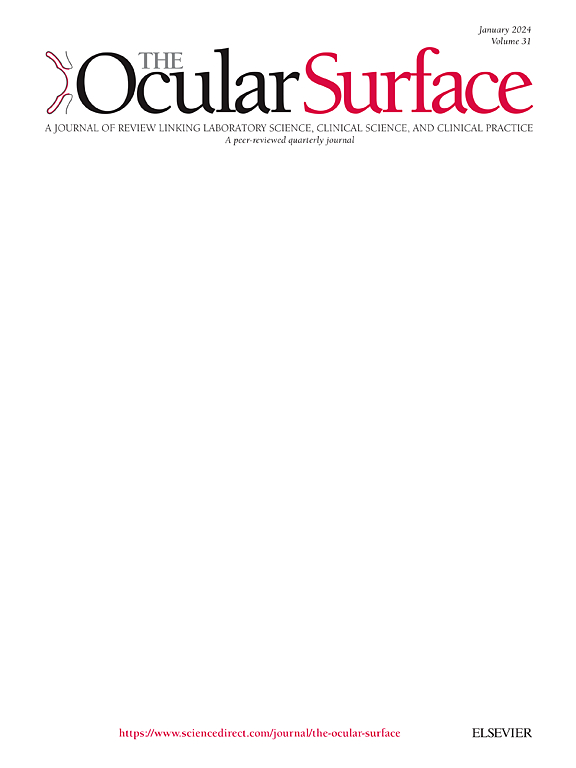造血干细胞移植对睑板腺结构的影响。
IF 5.6
1区 医学
Q1 OPHTHALMOLOGY
引用次数: 0
摘要
目的:探讨造血干细胞移植(HSCT)前后睑板腺(mg)的形态学变化。方法:尚未接受HSCT的参与者被纳入HSCT前组。两个眼睑的Meibography图像使用Pult's meiboscale进行分级,并使用半自动软件程序进行分析。将hsct前组的Meibography变量与健康参与者的对照组进行比较。随访组是hsct前组的一个子集,由hsct后随访至少6个月的参与者组成。观察眼表疾病指数(OSDI)、泪液破裂时间、角膜荧光素染色、Schirmer试验。我们分析了hsct前后的meibography变量和眼表测试的差异。结果:hsct前组和对照组分别有181名和24名参与者。hsct前组下眼睑的meiboscale高于对照组(2比1,p = 0.011)。随访组包括20例hsct后随访12.75个月的患者。HSCT后,上眼睑的meiboscale更高(2比1,p = 0.011),两眼睑的MG面积更低(上眼睑= 16.14%比21.49%,p = 0.001;下眼睑= 11.92% vs. 17.59%, p = 0.011),第二次访视时OSDI较首次访视增加(15.2 vs. 26.85, p = 0.018)。结论:在hsct前和后患者中观察到meibography的改变。这可能归因于hsct前治疗的效果,尽管长期的调节方案的附加效应不能被丢弃。本文章由计算机程序翻译,如有差异,请以英文原文为准。
Effect of hematopoietic stem cell transplantation on meibomian gland structure
Purpose
To assess morphological changes in the meibomian glands (MGs) pre- and post-hematopoietic stem cell transplantation (HSCT).
Methods
Participants yet to undergo HSCT were included in a pre-HSCT group. Meibography images of both lids were graded using Pult's meiboscale and analyzed using a semi-automatic software program. Meibography variables in the pre-HSCT group were compared with those in a control group of healthy participants. The follow-up group, a subset of the pre-HSCT group, comprised participants followed up for at least 6 months post-HSCT. Ocular Surface Disease Index (OSDI), tear break-up time, corneal fluorescein staining, and Schirmer test were performed. The differences in meibography variables and ocular surface tests pre- and post-HSCT were analyzed.
Results
Pre-HSCT and control groups comprised 181 and 24 participants, respectively. The pre-HSCT group had a higher meiboscale in the lower lid (2 vs. 1, p = 0.011) than controls. The follow-up group comprised 20 patients followed up for 12.75 months post-HSCT. After HSCT, the meiboscale of the upper lid was higher (2 vs. 1, p = 0.011), the MG area was lower in both lids (upper lid = 16.14 % vs. 21.49 %, p = 0.001; lower lid = 11.92 % vs. 17.59 %, p = 0.011), and the OSDI increased (15.2 vs. 26.85, p = 0.018) in the second visit compared to the first visit.
Conclusions
Alterations in meibography were observed in patients pre- and post-HSCT. This may be attributed to the effect of treatments administered pre-HSCT, although an additive effect of conditioning regimen in the long-term cannot be discarded.
求助全文
通过发布文献求助,成功后即可免费获取论文全文。
去求助
来源期刊

Ocular Surface
医学-眼科学
CiteScore
11.60
自引率
14.10%
发文量
97
审稿时长
39 days
期刊介绍:
The Ocular Surface, a quarterly, a peer-reviewed journal, is an authoritative resource that integrates and interprets major findings in diverse fields related to the ocular surface, including ophthalmology, optometry, genetics, molecular biology, pharmacology, immunology, infectious disease, and epidemiology. Its critical review articles cover the most current knowledge on medical and surgical management of ocular surface pathology, new understandings of ocular surface physiology, the meaning of recent discoveries on how the ocular surface responds to injury and disease, and updates on drug and device development. The journal also publishes select original research reports and articles describing cutting-edge techniques and technology in the field.
Benefits to authors
We also provide many author benefits, such as free PDFs, a liberal copyright policy, special discounts on Elsevier publications and much more. Please click here for more information on our author services.
Please see our Guide for Authors for information on article submission. If you require any further information or help, please visit our Support Center
 求助内容:
求助内容: 应助结果提醒方式:
应助结果提醒方式:


